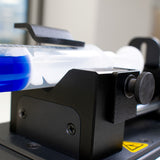Fixed vs Variable Occlusion in Peristaltic Pumps
The occlusion mechanism in peristaltic pumps is one of the most critical design decisions in their development. It impacts everything from the operational performance of the pump to the longevity of parts and components. The choice between a fixed or variable occlusion carries significant implications for both the manufacturers of the pumps and the end users.
Design Principles
At its core, a peristaltic pump operates through the progressive compression and relaxation of a flexible tube. The method of compression distinguishes a fixed occlusion design from a variable occlusion. If we start with the more basic design of the fixed occlusion system, the occlusion gap (h) adheres to a simple relationship given by:
The design of a fixed occlusion pump typically includes a bearing housed in a precision-machined bearing block. The bearing block is attached to the shaft of a motor for controlling the rotation speed. The bearings remained fixed in a constant position and so the occlusion gap remains constant.
Variable occlusion uses a method of dynamic adjustment of the compression gap, which is a function of a force applied to the roller. The occlusion gap then becomes a function of the force:
Most designs of variable occlusion pumps achieve this force via a spring-loaded mechanism where each roller is mounted to a sliding carriage with a spring under compression acting on it. By varying the level of compression of this spring, the force applied to the roller carriage and, through this, the roller can be varied via the equation:
The additional compression is typically adjusted using a calibrated screw or micrometer to allow for fine repeatable adjustment of the springs compression.
Differences in Performance
Flow Rates
Both types of occlusion mechanisms can provide highly accurate pump rates. Fixed occlusion pumps can achieve variations in flow rate as low as 1-2%, yet variable occlusion pumps can provide much higher levels of precision. Some variable systems achieve flow rate variations around an order of magnitude lower than fixed occlusion pumps. The main reason for this is that the force adjustment allows optimization for tubing materials and fluid properties, which improves the recovery time of the tubing from deformation. However, the thermal behavior is less predictable than in fixed occlusion pumps as the spring constant of the system exhibits non-linear behavior, so compression forces can vary considerably with changes in temperature.
In both systems, flow rate precision is heavily dependent upon manufacturing quality of components such as the tubing, occlusion mechanism, and motor driver electronics. The variation in flow rate also follows a predictable linear relationship with regards to temperature changes which is mostly dependent upon the change in tubing geometry.
Tube Compression
One of the main advantages of variable occlusion pumps is that, with a controllable force, you can set the optimal amount for compression of the tube based upon the tubing material and solution used. In fixed occlusion systems, it is easy to over compress tubing leading to additional fatigue and wear over time.
Generally, variable occlusion systems need fewer tube replacements and less downtime for maintenance. This can be highly advantageous when using expensive high-precision tubing or high-performance materials for chemical compatibility.
Fixed or Variable Occlusion?
| Fixed Occlusion Pumps | Variable Occlusion Pumps |
|---|---|
| Lower initial investment to get the system up and running. | Ultra-high precision solution delivery for applications that require greater accuracy. |
| Ideal in applications when processes and materials remains the same, like high-volume manufacturing or in research areas where the tubing and solutions rarely change. | Ideal when working with a wide range of materials that benefit from optimization specific to the fluid or tubing properties. |
| Easy to over compress the tubing without compression control. | Correctly optimized compression can extend tubing lifetime. |
Read More
Peristaltic pumps are a type of positive displacement pump that use the progressive compression and relaxation of a flexible tube to move fluid along. These pumps mirror the biological process called peristalsis.
Read more... Calibration of Peristaltic Pumps
Calibration of Peristaltic Pumps
Calibration of peristaltic pumps is far more than a simple adjustment of flow rates. Instead, it requires an understanding of the complex interactions between the mechanical system, materials properties, and fluid dynamics. The calibration processes are designed to account for variations in tube properties, mechanical tolerances in the systems design and manufacture, and environmental conditions that can change the properties of the fluids being pumped. Proper calibration of your peristaltic pump ensures not only accurate flow rates but can improve tube lifetime, improve consistency in fluid delivery, and improve process control.
Read more...